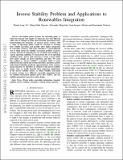| dc.contributor.author | Vu, Thanh Long | |
| dc.contributor.author | Nguyen, Hung Dinh | |
| dc.contributor.author | Megretski, Alexandre | |
| dc.contributor.author | Slotine, Jean-Jacques E | |
| dc.contributor.author | Turitsyn, Konstantin | |
| dc.date.accessioned | 2020-06-11T21:23:53Z | |
| dc.date.available | 2020-06-11T21:23:53Z | |
| dc.date.issued | 2017-10 | |
| dc.identifier.issn | 2475-1456 | |
| dc.identifier.uri | https://hdl.handle.net/1721.1/125775 | |
| dc.description.abstract | In modern power systems, the operating point, at which the demand and supply are balanced, may take different values due to changes in loads and renewable generation levels. Understanding the dynamics of stressed power systems with a range of operating points would be essential to assuring their reliable operation, and possibly allow higher integration of renewable resources. This letter introduces a non-traditional way to think about the stability assessment problem of power systems. Instead of estimating the set of initial states leading to a given operating condition, we characterize the set of operating conditions that a power grid converges to from a given initial state under changes in power injections and lines. We term this problem as "inverse stability," a problem which is rarely addressed in the control and systems literature, and hence, poorly understood. Exploiting quadratic approximations of the system's energy function, we introduce an estimate of the inverse stability region. Also, we briefly describe three important applications of the inverse stability notion: 1) robust stability assessment of power systems with respect to different renewable generation levels; 2) stability-constrained optimal power flow; and 3) stability-guaranteed corrective action design. ©2017 IEEE. | en_US |
| dc.description.sponsorship | MIT/Skoltech, Ministry of Education and Science of Russian Federation (Grant no.14.615.21.0001.) | en_US |
| dc.description.sponsorship | NSF (1508666) | en_US |
| dc.description.sponsorship | NSF (1550015) | en_US |
| dc.publisher | Institute of Electrical and Electronics Engineers (IEEE) | en_US |
| dc.relation.isversionof | https://dx.doi.org/10.1109/LCSYS.2017.2764040 | en_US |
| dc.rights | Creative Commons Attribution-Noncommercial-Share Alike | en_US |
| dc.rights.uri | http://creativecommons.org/licenses/by-nc-sa/4.0/ | en_US |
| dc.source | arXiv | en_US |
| dc.title | Inverse Stability Problem and Applications to Renewables Integration | en_US |
| dc.type | Article | en_US |
| dc.identifier.citation | Vu, Thanh Long, Hung Dinh Nguyen, Alexandre Megretski, Jean-Jacques Slotine, and Konstantin Turitsyn. “Inverse Stability Problem and Applications to Renewables Integration.” IEEE Control Systems Letters 2, 1 (January 2018): 133–138. doi. 10.1109/lcsys.2017.2764040. ©2018 Authors | en_US |
| dc.contributor.department | Massachusetts Institute of Technology. Department of Mechanical Engineering | en_US |
| dc.contributor.department | Massachusetts Institute of Technology. Department of Electrical Engineering and Computer Science | en_US |
| dc.contributor.department | Massachusetts Institute of Technology. Department of Brain and Cognitive Sciences | en_US |
| dc.relation.journal | IEEE Control Systems Letters | en_US |
| dc.eprint.version | Author's final manuscript | en_US |
| dc.type.uri | http://purl.org/eprint/type/JournalArticle | en_US |
| eprint.status | http://purl.org/eprint/status/PeerReviewed | en_US |
| dc.date.updated | 2019-01-03T15:08:09Z | |
| dspace.orderedauthors | Vu, Thanh Long; Nguyen, Hung Dinh; Megretski, Alexandre; Slotine, Jean-Jacques; Turitsyn, Konstantin | en_US |
| dspace.embargo.terms | N | en_US |
| dspace.date.submission | 2019-04-04T14:44:27Z | |
| mit.journal.volume | 2 | en_US |
| mit.journal.issue | 1 | en_US |
| mit.license | OPEN_ACCESS_POLICY | en_US |
| mit.metadata.status | Complete | |
